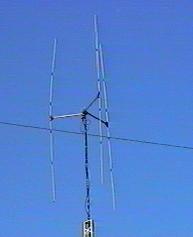

This is the Antenna Specialists "Super Scanner", an electrically phased combination beam/omni antenna. This antenna was marketed as the answer for those people who wanted to run both a directional beam antenna, and an omni-directional ground plane antenna, but either could not afford to, or did not have the space to put two separate antennas up. This antenna design, through the "magic" of electronic phasing, allowed it to operate as both an omni-directional antenna, or as a directional antenna with a choice of 3 major lobes spaced 120 degrees apart (typically North, Southwest and Southeast). This switching was accomplished by a control box connected to the antenna by multi-conductor cable. The antenna boasted impressive gain ratings of 5.75 dbi in the omni mode, and 8.75 dbi in the directional mode. These gain numbers impressed a great many people who then went out and bought the antenna. But the real world proved to be much less kind to the owners of these antennas.....
So now for the bad news. As most of us know, anytime you have a compromise, you learn that it doesn't perform any of its tasks as well as separate dedicated devices. The same principle held true for this antenna. As an omni, its performance was less than a typical 5/8th wave ground plane. Switch the Super Scanner to the beam mode and it would edge out a ground plane, but not by as much as a 3 element yagi would. Then there is that all-important other feature, that a person who wants a beam looks for, rejection. A directional beam typically can reduce a signal by at least 25 to 35 db when it is turned away, thereby significantly reducing interference from stations in other directions. The Super Scanner, due to its relatively wide lobes, tended to only drop signals 1 to 2 "S" units (Which should be about equal to 6 - 12 db) when pointed away. So as you can see, it really wasn't the best omni, or the best beam. There were other shortcomings too. The older versions of the antenna used a coaxial stub to match the impedance when in the omni mode. You could run a fairly good amount of power through it with no problem. But the newer version used a different impedance transforming scheme (internal inductors and capacitors), which could only reportedly take about 50 watts or so before burning out. Running in the directional mode, and you could run up to 1500 watts with no problem. But you only had to forget once and switch back to omni with the amp on and POOF! You also had to refrain from running high power and switching the antenna to a different direction while keyed, or you risked welding the switching relay contacts, which was also what usually happened if one of these antennas was the unfortunate victim of a lightning strike.
Some people tried working around the inherent design limitations of this antenna. A few actually mounted a rotator under it, so as to "fill in" the nulls in between the 120 degree lobes. But for all that trouble, they probably should have just bought a 3 element yagi. There were a few guys who ran Super Scanners as "spotter" beams for their much larger "Moonraker" and "Laser" beam antennas. They'd use the "SS" as their omni, and to get a rough idea which direction a station was coming from in order to accurately turn the "big" beam.
In our group, Blue Bandit, Rebel, Big Mac, and others ran them for a spell. Most moved on to better antennas.